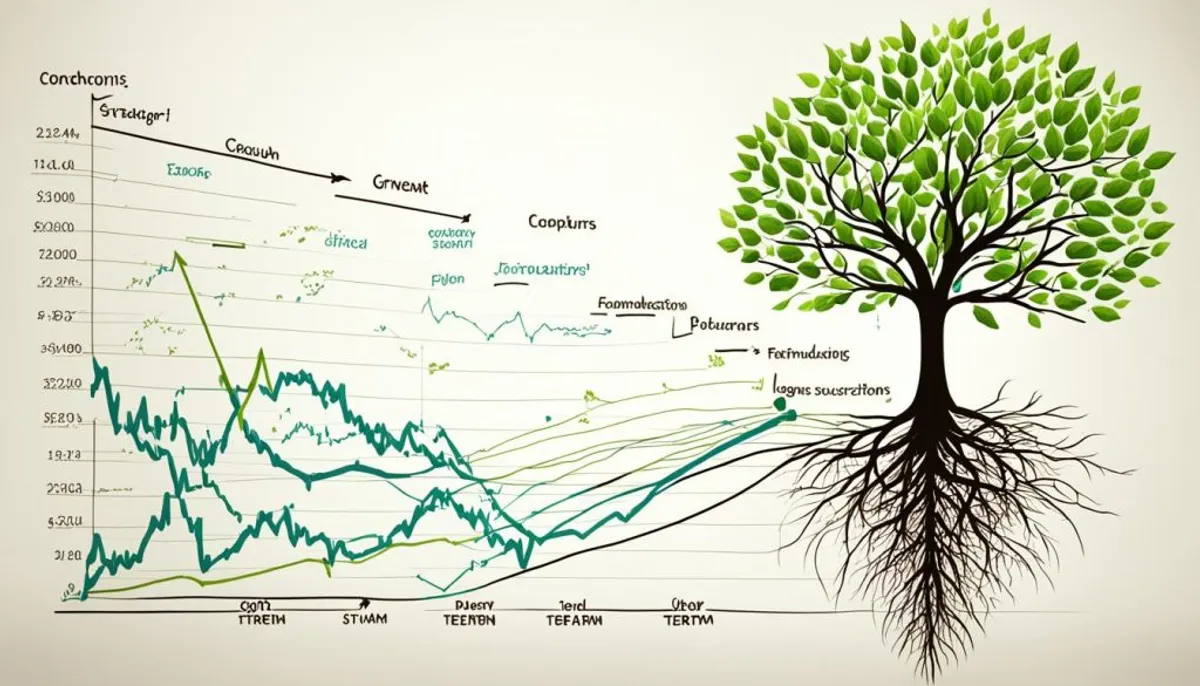SEO, or search engine optimization, doesn’t offer quick fixes or instant wins. It’s a long-term strategy that needs you to keep at it and have patience. Wanting fast results is normal, but remember, lasting success in SEO takes time to build.
So, what makes SEO a long-term approach? Let’s explore why showing patience is crucial. Especially for goals like getting your site seen more, growing your organic traffic, and setting up a strong content marketing plan.

Key Takeaways:
- SEO needs steady work and focus over time.
- It takes a while to build a strong online space, but it’s worth it.
- Knowing what affects how long SEO takes helps to be realistic.
- Being patient is crucial since big changes might take months.
- Good, honest SEO methods and smart digital marketing are key for success in the long run.
Why Does SEO Take So Long?
SEO needs time to show results because of many factors. According to SEO expert Sreeram Sharma, you might see changes in about 6 months. A study by Ahrefs mentioned it can take 3-6 months to notice significant changes.
Google uses crawlers to look at websites. They need time to check and rank webpages. It’s not just the website, but also building a strong online presence with quality backlinks.
Good content is key in SEO. You need to research and create content that both people and search engines like. Optimizing the site for better speed, mobile use, and user experience is also crucial.
Another factor is the level of competition. If your industry is crowded, climbing up the ranks could take more time. Each of these aspects influences how long SEO takes to work.
Factors Influencing SEO Timeline:
- Time for Google’s crawlers to analyze websites
- Building domain authority through backlinks
- Creating quality content aligned with search engine algorithms
- Technical optimization of the website
- Competition within the industry
| Common Factors Influencing SEO Timeline | Timeframe |
|---|---|
| Website analysis by Google’s crawlers | Varies for each website |
| Building domain authority through backlinks | Months to years |
| Creating quality content | Ongoing process |
| Technical optimization of the website | Varies based on website complexity |
| Competition within the industry | Varies based on industry and competitiveness |
Setting Yourself Up for Long-Term SEO Success
To succeed in SEO long-term, it’s key to have a clear, defined strategy. This strategy should focus on improving website visibility and attracting the right audience. Key steps include audience research, creating high-quality content, building links, and keeping an eye on SEO performance.
Audience Research: Tailoring Your Website to Consumer Needs
Conducting deep audience research is crucial for an SEO strategy. Know what your audience wants and needs by looking at their interests and trends. Use this info to make your website more appealing and useful to them.
This also involves using data, researching keywords, and understanding user actions. These efforts help create a website that truly connects with your audience.
High-Quality Content Creation: Attracting and Engaging Your Audience
Producing top-notch content is essential for SEO success. Offer content that your audience wants and that helps them. Focus on being informative, engaging, and addressing their needs to attract visitors and build your authority.
You can create various types of content, such as articles, videos, and infographics. Make sure it’s valuable and leaves your audience wanting more.
Link Building: Building Authority and Trust
Link building, both internal and external, is also critical for SEO. Use internal links to organize your site for search engines. External links from respected sites boost your credibility online.
Getting backlinks from trustworthy sources within your field helps your site’s ranking and visibility.
Monitoring SEO Results: Making Data-Driven Decisions
It’s vital to keep track of your SEO results. Watch metrics like traffic and conversions to see what’s working and what needs improvement. Use tools like Google Analytics to help you make informed choices on how to tweak your SEO strategy over time.
A thorough SEO strategy involves all these aspects. With the right approach and continuous work, you can achieve lasting success in SEO.
Now, we’ll dive into some case studies that prove the impact of long-term SEO strategies.

| Case Study | Company | Results |
|---|---|---|
| Mailmodo’s SEO Success | Mailmodo | Increased organic traffic by 100% through consistent content creation and organic backlink building. |
| GR0’s SEO Success | GR0 | Helped client, AdQuick, increase organic traffic by over 915% in 12 months through diverse SEO strategies. |
| David Ramos’ SEO Story | David Ramos | After 6 months of no traffic, his article on chess books started receiving high traffic and became one of his highest-trafficked pages. |
The Benefits of SEO Strategy
A long-term SEO strategy can give a website a big boost. It brings many benefits that can really improve how well a site does.
Increased Credibility
SEO helps a site appear higher in search results. This makes users think the site is trustworthy and of good quality. It increases a site’s credibility.
Higher Return on Investment (ROI)
Compared to old marketing ways, SEO is better at getting more for your money. It drives organic traffic, finding users already looking for what you offer. This increases your chances of making a sale, earning more from your investment.
Quality Traffic and Target Audience Reach
SEO’s main plus is sending the right people to your site. It makes sure those who see your site are looking for what you offer. Also, it helps you connect with every step of your customer’s journey, from first learning about you to making a purchase.
Better Local Search Rankings
More people search locally now, using their devices. Local SEO helps your site show up when they do. This can really boost your business by making it easier for nearby customers to find you.
Constant Promotion
SEO keeps promoting your site all the time. After it starts ranking well, the traffic keeps coming without you spending more. It’s a great help for those working with small budgets, keeping their presence known online without constantly paying for ads.
Case Studies: Success Stories of Long-Term SEO Strategies
Real-life examples highlight the power of long-term SEO strategies. They show why investing in SEO is key. Let’s look at notable cases from Mailmodo, GR0, and David Ramos.
Mailmodo’s SEO Success
Mailmodo found success with interactive emails and email marketing. They focused on creating top-notch content. This drew in organic backlinks, boosting their SEO game.
GR0’s SEO Success
GR0, an SEO leader, helped AdQuick soar by 915% in organic traffic in a year. Their approach mixed keyword magic, content gold, and link craftsmanship. GR0 and AdQuick’s teamwork led to massive growth and better rankings.
David Ramos’s SEO Story
David Ramos, a savvy SEO expert, spins a tale of persistence. His chess books article stumbled at first but later hit big. This tale underscores the power of sticking to SEO strategies over time.
| Success Story | Company/Individual | SEO Strategy | Results |
|---|---|---|---|
| Mailmodo | Mailmodo | Building authority in interactive emails and email marketing | Consistent content creation, organic backlinks, improved SEO performance |
| GR0 | Diverse SEO strategies including keyword optimization, content creation, and backlink building | Over 915% increase in organic traffic for AdQuick | |
| David Ramos’s Chess Books Article | David Ramos | Consistent promotion, persistence with SEO efforts | One of the highest-trafficked pages due to long-term SEO strategies |
These stories underline how long-term SEO drives success. By aiming for authority, using various tactics, and staying patient, growth is possible. Let’s learn from Mailmodo, GR0, and David Ramos.
Understanding the SEO Process
Long-term success in SEO needs a firm grasp of basic ideas. SEO stands for search engine optimization. It’s about making a website show up better in search engines, which brings in more visitors.
SEO has three main areas to focus on:
- On-Page SEO: This includes making each web page better for specific searches. It means fixing things like titles, content, and choosing the right words seamlessly.
- Off-Page SEO: This part works on getting other sites to link to yours and adding social signals. It involves things like getting posts on other blogs or making a mark on social media.
- Technical SEO: Technical SEO improves how a website works under the hood. It includes making sure the site runs smoothly, loads fast, and does what search engines like.
“Grasping and using these three SEO aspects can lift a site’s search visibility and ranking.”
Working on these pillars together, website owners and experts lay the groundwork for SEO success. Following trends and making adjustments help keep SEO strategies powerful and relevant.
Now, let’s see visually how SEO components fit together:
SEO Process Overview
| Step | Description |
|---|---|
| 1. | Find key words and topics by doing keyword research. |
| 2. | Improve on-page parts like titles and content. |
| 3. | Make content that fits key words and meets what users want. |
| 4. | Start good links to your website and promote your content. |
| 5. | Make sure your website works well for search engines technically. |
| 6. | Use tools to watch and understand website performance. |
| 7. | Upgrade your SEO plan by learning from the data. |
Following these seven steps and using smart SEO can boost your site’s visibility. This increases visitors and makes your digital space better overall.
Factors Affecting SEO Results
SEO results depend on many factors. These include your website’s age and authority. They also consider the competition in your industry and the quality of your website’s content. Knowing these can guide your efforts and help your website get noticed more.
Website Age and Authority
Older websites usually rank better. They’ve had more time to show search engines their authority and trustworthiness. New websites, though, can rise in rankings by consistently putting out great content and linking well.
Competition in the Industry
In a highly competitive industry, achieving good SEO results might take longer. How you stack up against your rivals matters. Working on a strong strategy that makes you stand out can speed up your success.
Content Quality
Valuable, relevant, and engaging content is a must. Search engines reward sites that offer this. Use the right keywords, format well, and have informative headlines to boost your content’s quality.
Technical SEO Issues
Technical issues can hold back your SEO efforts. Problems like slow loading times and unresponsive mobile sites aren’t good. Regularly checking for these issues and fixing them can keep your site in good shape for search engines.
Backlink Building
Having strong backlinks is key. They show search engines your website is important and trusted. But, getting good backlinks takes effort. It involves connecting with others and producing top-notch content.
Algorithm Updates
Search engine rules always change, affecting your site’s ranking. Updates like Google’s can shake up your SEO strategy. It’s vital to stay in the know and adjust your website accordingly to keep up your good standing.

Doing well in SEO is about focusing on these factors and using smart strategies. Remember, SEO success grows over time. Being consistent with quality content, keeping your site technically sound, and staying informed are your best bets for lasting achievements.
How Long Does It Take to See Results?
SEO needs time to show results. The time it takes can change based on many things. But, in about 3-6 months, you might see some progress from your SEO work.
If your website starts to rank better for specific, narrow keywords, that’s a good sign. These keywords might not be searched often, but they bring focused visitors. It shows your SEO is working.
Getting better rankings for long-tail keywords is a good step in SEO.
– An SEO expert says so
Seeing more organic traffic is another clue that you’re on the right path. Organic traffic comes from search engines, not ads or social media. Watching your website’s traffic increase is a clear sign of progress.
Having your website show up more in search results is also key. The more often it’s seen, the more people might visit. This visibility means SEO is working for you.
These early signs of success are great to see. But, real achievement in SEO takes longer. It might be 6-12 months before you’re at the top for big keywords and have a strong online presence. SEO work is steady and demands ongoing focus and patience.
SEO Results Timeline
| Timeframe | Signs of SEO Progress |
|---|---|
| 3-6 months | Improved rankings for long-tail keywords Increased organic traffic Enhanced website visibility |
| 6-12 months or more | Achieving top positions for competitive keywords Building a strong online presence |
Keep at your SEO tasks and keep checking how you do. Don’t lose heart if you don’t see changes right away. SEO is about the long haul and needs regular work and patience.
Conclusion
SEO is a long-term game. It needs continuous work and focus. The payoff comes over time, showing the value of sticking with it. With a strong SEO strategy and dedication, lasting success in the online world is possible.
SEO helps bring more people to your site for free. By choosing the right keywords, improving content, and building links, your website can rank higher in search results. This means more people finding and visiting your site, boosting your business’s success without huge costs.
In addition, a good SEO strategy can make your brand more trusted and known. By always creating useful content and tuning your site for searches, your brand can stand out. This builds trust with customers and keeps them coming back over time.
In summary, the benefits of SEO are clear despite the time it takes. With a good plan, hard work, and maybe some professional help, you can do well online. It’s a journey that’s rewarding for those who stay the course.
FAQ
Why does SEO take so long?
SEO takes time due to many reasons. Search engine crawlers need time to check your site. You also need to gain domain authority with backlinks and make great content. The competition affects how soon you’ll see results.
How can I set myself up for long-term SEO success?
To succeed long-term in SEO, start with a great strategy. This means knowing your audience, making top-notch content, and earning good links. It’s also about watching your SEO moves and adjusting based on what you learn.
What are the benefits of an SEO strategy?
Using SEO can make your site more trusted and seen. It’s better than traditional ads for saving money and getting good visitors. You’ll show up higher in local searches and keep promoting your site ongoing.
Can you provide any success stories of long-term SEO strategies?
There are great examples of SEO success. For instance, Mailmodo improved their emails and marketing over time. They worked hard on their content and earned links naturally.
GR0 also did well, helping AdQuick boost traffic by 915% in a year. They used different SEO tactics to reach this goal.
What are the basic concepts of SEO?
SEO is all about making your site more visible on search pages. It’s got three main parts: on-page, off-page, and technical SEO.
The first deals with your web pages. The second is about links, and the last is about how your site is built and coded.
What factors can affect SEO results?
A lot can influence how well your SEO works. The age and power of your site matter, as does your industry’s competition.
Your content quality and technical issues are key too. Plus, how you get backlinks and changes in search engines’ rules can impact your SEO.
How long does it take to see results from SEO?
Results in SEO don’t show up overnight. Often, you’ll start seeing changes in 3-6 months. But for big wins, it might take a year or more. Being patient and working steadily are crucial.
RelatedRelated articles



